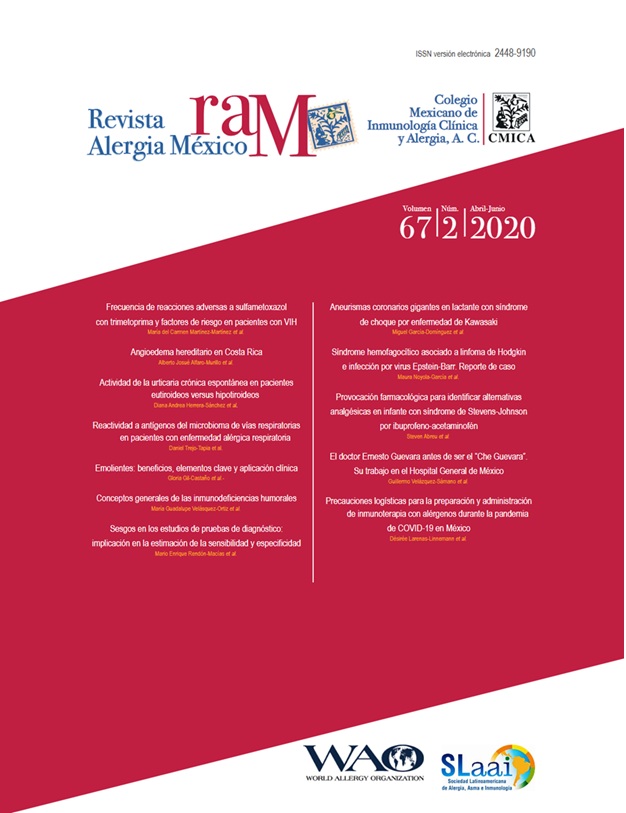Abstract
Background: Trimethoprim-sulfamethoxazole (TMP-SMZ) is the long-term use antimicrobial of choice in the prevention and treatment of opportunistic germs in patients with acquired immunodeficiency syndrome (AIDS) in whom the frequency of ADR (adverse drug reactions) is of 30% to 50 %.
Objective: To determine the adverse reactions to TMP-SMZ and their risk factors in AIDS patients.
Methods: The patients included in the study were older than 18 years of age, admitted from January 2018 to May 2019 with a confirmed diagnosis of HIV, and had had adverse drug reactions; 319 files were reviewed.
Results: A frequency of 13.16 % in adverse reactions was reported; out of 42 patients with ADR, 23 had had ADR to TMP-SMZ (54.76 %). The highest rate of adverse reactions was represented by a rash, with 56.5 %, followed by angioedema, with 21.73 %, and nettle rash, with 17.39 %. The risk factors were: infectious comorbidity (OR = 2.6) and CD4 count < 100 (OR = 6.9), without statistical significance. The dose of TMP/SMZ was a risk factor (OR = 12.7) with p = 0.017.
Conclusions: TMP-SMZ used in AIDS patients reached 54 % of the adverse drug reactions, and the dose of this medication was a risk factor.
References
Esteban CS. VIH: infección aguda, pesquisa y manejo. Rev Med Clin Condes. 2014;25(3):419-424. DOI: 10.1016/S0716-8640(14)70058-6
Carrillo-Maravilla E, Villegas-Jiménez A. El descubrimiento del VIH en los albores de la epidemia del sida. Rev Invest Clin. 2004;56(2):130-133.
Organización Mundial de la Salud [Internet]. Suiza: Estrategia mundial del sector de la salud contra el VIH, 2016-2021; 2016. Disponible en: https://apps.who.int/iris/bitstream/handle/10665/250574/WHO-HIV-2016.05-spa.pdf;jsessionid=912DD3394CC0E8804670B87BE6E44A13?sequence=1
Secretaría de Salud/Centro Nacional para la Prevención y el Control del VIH y sida/Dirección General de Epidemología [Internet]. Vigilancia epidemiológica de casos de VIH/sida en México. México: Registro nacional de casos de sida. Actualización al 2do. trimestre del 2019: Documentos; 2019. Disponible en: https://www.gob.mx/cms/uploads/attachment/file/488177/RN_2doTrim_2019.pdf
Woodman Z, Williamson C. HIV molecular epidemiology: transmission and adaptation to human populations. Curr Opin HIV AIDS. 2009;4(4):247-252. DOI: 10.1097/COH.0b013e32832c0672
Juno JA, Bockel DV, Kent SJ, Kelleher AD, Zaunders JJ, Munier ML. Cytotoxic CD4T cells-Friend or Foe during viral infection? Front Immunol. 2017; 8:19. DOI: 10.3389/fimmu.2017.00019
Sánchez-Martínez A, Perdomo-Celis F, Acevedo-Sáenz L, Rugeles MT, Velilla PA. Cytotoxic CD4 T cells during HIV infection: targets or weapons. J Clin Virol. 2019;119:17-23. DOI: 10.1016/j.jcv.2019.08.004
Terrazas-Estrada JJ. A 30 años de la infección por el virus de la inmunodeficiencia humana. Rev Alerg Mex. 2011;58(4):205-212. Disponible en: https://www.elsevier.es/es-revista-revista-alergia-mexico-336-articulo-a-30-anos-infeccion-por-X0002515111905711
Chevalier MF, Didier C, Girard PM, Manea ME, Campa P, Barré-Sinoussi F, et al. CD4 T-cell responses in primary HIV infection: interrelationship with immune activation and virus burden. Front Immunol. 2016;7:1-7. DOI: 10.3389/fimmu.2016.00395
Paul ME, Shearer WT, Kozinetz CA, Lewis DE. Comparison of CD8(+)T-cell subsets in HIV-infected rapid progressor children versus non-rapid progressor children. J Allergy Clin Immunol. 2001;108(2):258-264. DOI: 10.1067/mai.2001.117179
Sisay M, Bote D, Edessa D, Mengisto G, Amare F, Gashaw T, et al. Appropriateness of cotrimoxazole prophylactic therapy among HIV/AIDS patients in public hospitals in Eastein Ethiopia: a retrospective evaluation of clinical practice. Front Pharmacol. 2018;9:727. DOI: 10.3389/fphar.2018.00727
Moreno E, Moreno A. Alergia a los fármacos en el paciente con infección por el VIH. Alergia a otros agentes antiinfecciosos poco habituales: antirretrovirales, sulfamidas, antituberculosos y otros. En: Tratado de Alergología. España: Ergon; 2019. pp. 1437-1460
Carr A, Swanson C, Penny R, Cooper DA. Clinical and laboratory markers of hypersensitivity to trimethoprim-sulfamethoxazole in patients with Pneumocystis carinii pneumonia and AIDS. J Infect Dis. 1993;167(1):180-185. DOI: 10.1093/infdis/167.1.180
Veenstra J, Veugelers PJ, Keet IP, van der Ven AJ, Miedema F, Lange JM, et al. Rapid disease progression in human immunodeficiency virus type 1-Infected individuals with adverse reactions to trimetoprim-sulfamethoxazole prophylaxis. Clin Infect Dis. 1997;24:936-941. DOI: 10.1093/clinids/24.5.936
Belchi-Hernández J, Espinosa-Parra FJ. Management of adverse reactions to prophylactic trimethoprim-sulfamethoxazole in patients with human immunodeficiency virus infection. Ann Allergy Asthma Immunol. 1996;76(5):355-358. DOI: 10.1016/S1081-1206(10)60037-3
Shafer RW, Seitzman PA, Tapper ML. Successful prophylaxis of Pneumocystis carinii pneumonia with trimethoprim-sulfamethoxazole in AIDS patients with previous allergic reactions. J Acquir Immune Defic Syndr. 1989;2(4):389-393.
Rabaud C, Charreau I, Izard S, Raffi F, Meiffredy V, Lepor C, et al. Adverse reactions to cotrimoxazole in HIV-infected patients: predictive factors and subsequent HIV disease progression. Scand J Infect Dis. 2001;33(10):759-764. DOI: 10.1080/003655401317074581
Chang HM, Tsai HC, Lee SSJ, Kunin C, Lin PC, Wan SR, et al. High daily doses of trimethoprim/sulfamethoxazole are an independent risk factor for adverse reactions in patients with pneumocystis pneumonia and AIDS. J Clin Med Assoc. 2016;79(6):314-319. DOI: 10.1016/j.jcma.2016.01.007

This work is licensed under a Creative Commons Attribution-NonCommercial 4.0 International License.
Copyright (c) 2020 Revista Alergia México





